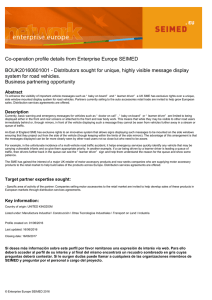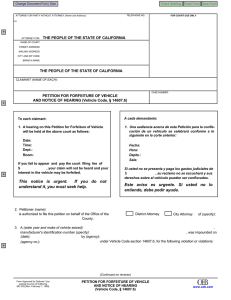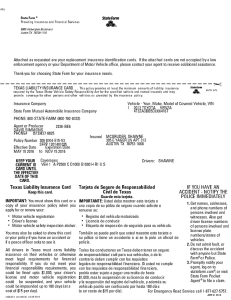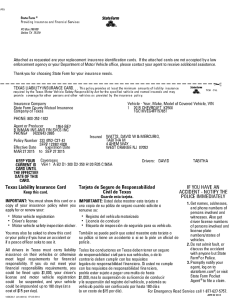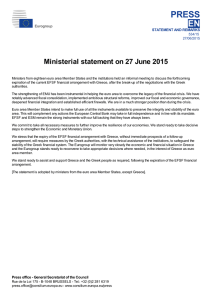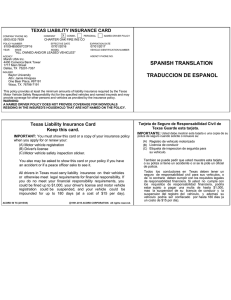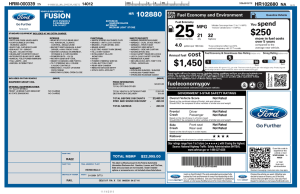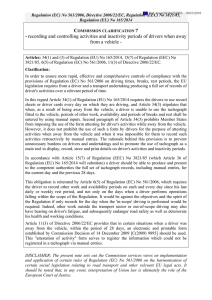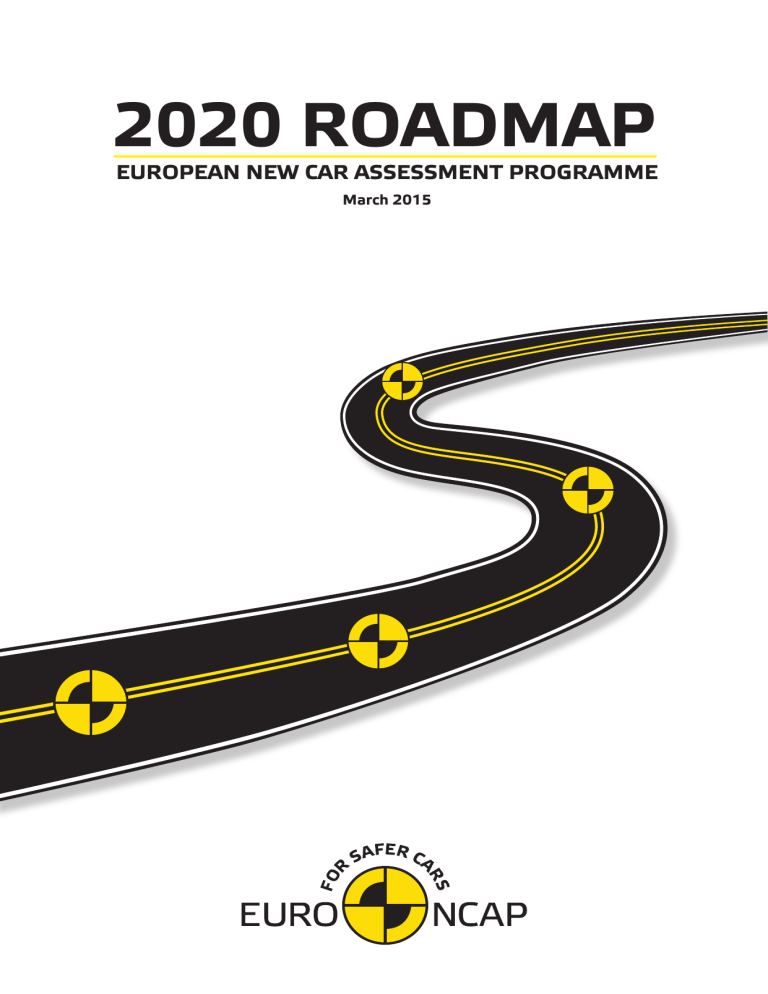
2020 ROADMAP EUROPEAN NEW CAR ASSESSMENT PROGRAMME March 2015 E X E C U T I V E S U M M A RY The European New Car Assessment Programme, Euro NCAP, provides motoring consumers with an objective and independent assessment of the safety performance of new vehicles on the European market. The way that vehicles are developing means that Euro NCAP ’s tests must continue to evolve and take account of the newest, essential safety technology on offer. In the years ahead, the roll out of vehicle automation is expected to accelerate development and availability of advanced sensors and driver-centred functions in the vehicle, each of which will need to have reliable and robust performance to deliver safety benefits. The findings of this roadmap have been produced through an open consultation of the key stakeholders in Euro NCAP and the automotive industry. The plan identifies four main domains that focus on the key real life crash scenarios and that can be addressed by new and updated vehicle technology, in particular in the field of crash avoidance. Besides introducing changes to the star rating scheme and carrying out ad-hoc safety tests, the organisation proposes to develop consumer-focused guidelines with industry that may facilitate the operability of driver assistance systems across the European fleet. 2 ACKNOWLEDGEMENTS The vision presented in this strategic document is based on an extended consultation carried out amongst Euro NCAP ’s most important stakeholders. The purpose of the consultation was to identify key challenges and priorities for vehicle safety in the years ahead. We gratefully acknowledge the following organisations for sharing their valuable insight into the future of vehicle safety and for taking the time to meet with us (in alphabetical order): Audi, Autoliv, Robert Bosch, BMW Group, Continental, Daimler, Denso, Honda Motor Company, IEE, Japanese Automobile Manufacturers Association (JAMA), Nissan Motor Company, Adam Opel, PSA Peugeot Citroën, Renault, Takata, Toyota Motor Europe, TRW, Volkswagen Group and Volvo Car Corporation. The views expressed in this document are shared and agreed by the Board members of Euro NCAP. This version, dated Wednesday 4th March, 2015, includes minor adjustments to the timing of deliverables that were made during the definition of the detailed rating scheme in 2015. 3 TA B L E O F C O N T E N T S background . . . . . . . . . . . . . . . . . . . . . . . . . . . . . . . . . . . . . . . . . . . . . . . . . . . . . . . . . scope . . . . . . . . . . . . . . . . . . . . . . . . . . . . . . . . . . . . . . . . . . . . . . . . . . . . . . . . . . . . . . . . . benefits . . . . . . . . . . . . . . . . . . . . . . . . . . . . . . . . . . . . . . . . . . . . . . . . . . . . . . . . . . . . . . 3.1 The Road Traffic Injury Problem . . . . . . . . . . . . . . . . . . . . . . . . . . . . . . . . . . 3.2 Priorities, Opportunities and Challenges . . . . . . . . . . . . . . . . . . . . . . . . . . 3.3 Risks and Threats . . . . . . . . . . . . . . . . . . . . . . . . . . . . . . . . . . . . . . . . . . . . . . . . . 3.4 Expected Impacts on Industry and Society . . . . . . . . . . . . . . . . . . . . . . . . 4 target actions . . . . . . . . . . . . . . . . . . . . . . . . . . . . . . . . . . . . . . . . . . . . . . . . . . . . . 4.1 Vehicle Safety Ratings . . . . . . . . . . . . . . . . . . . . . . . . . . . . . . . . . . . . . . . . . . . . . 4.2 Advanced Rewards . . . . . . . . . . . . . . . . . . . . . . . . . . . . . . . . . . . . . . . . . . . . . . . 4.3 Campaigns . . . . . . . . . . . . . . . . . . . . . . . . . . . . . . . . . . . . . . . . . . . . . . . . . . . . . . . 4.4 Consultation . . . . . . . . . . . . . . . . . . . . . . . . . . . . . . . . . . . . . . . . . . . . . . . . . . . . . . 4.5 International Cooperation . . . . . . . . . . . . . . . . . . . . . . . . . . . . . . . . . . . . . . . . 5 key deliverables and milestones . . . . . . . . . . . . . . . . . . . . . . . . . . . . . . . 5.1 Occupant Protection in Front and Side Crashes (Domain I) . . . . . . . 5.2 Autonomous Braking for Cars and VRU (Domain II) . . . . . . . . . . . . . . 5.3 Lateral Assist Systems (Domain III) . . . . . . . . . . . . . . . . . . . . . . . . . . . . . . . 5.4 Speed & Impaired Driving (Domain IV) . . . . . . . . . . . . . . . . . . . . . . . . . . 5.5 Fitment Rate Policy . . . . . . . . . . . . . . . . . . . . . . . . . . . . . . . . . . . . . . . . . . . . . . . 6 implementation and evaluation . . . . . . . . . . . . . . . . . . . . . . . . . . . . . . . . a appendix: strategy working group . . . . . . . . . . . . . . . . . . . . . . . . . . . . . 1 2 3 4 5 6 7 7 8 9 9 11 11 11 11 11 12 13 13 14 15 16 17 18 19 1 BACKGROUND The overall number of deaths on European roads has continued to decrease over the last decade thanks to a wider adoption of the safe system approach to road safety. In this approach the continued improvement of vehicle safety has been a highly effective means of making the system more robust and forgiving to human mistakes. The remarkable progress in vehicle safety during recent years has been largely delivered through industry innovation, effective legislation and consumer demand for safer vehicles. Combined with tangible advancements in road infrastructure and effective policies to reduce driving under the influence and speeding, the development of a safer vehicle fleet has made Europe’s road transport one of the world’s safest. In 2010, the European Commission launched a new EU Road Safety programme1 which aims to cut the number of road deaths by half by 2020. The release of the plan, which amongst others promotes the development of more intelligent (or connected) vehicles, coincided with the adoption of new emission reduction targets that have boosted the rollout of electromobility in Europe. New urban mobility solutions are emerging, which consider different co-existing and/or co-shared forms of mobility and which are promoting new vehicle concepts such as the electric heavy quadricycle or light city car. At the same time, vehicles are increasingly becoming digital platforms offering satellite navigation, infotainment, internet connectivity and telematics systems with Human-Machine Interface (HMI) solutions that may involve nomad devices. While much is done to improve comfort, safety and entertainment onboard the vehicle, distracted driving has become an increasing concern. Last but not least, the idea of automated and self-driving cars has been widely aired in technical discussion and in media coverage recently. The rapid development of electronic safety systems has made the concept possible and prototype systems are able to “drive” in controlled situations. The vehicle industry is active in this field but new players such as Google have also shown prototypes. The next ten years will therefore involve great changes and challenges when it comes to vehicle safety. There is no doubt that greater automation will drive a safety revolution, and this will mean putting safety above all other requirements and characteristics of a car. Not only will the self-driving car have the technology to sense, avoid and mitigate in potential crash scenarios, it will also drive in a safer manner. Besides that, used in a manual way, the vehicle will always carry the safety elements and technologies to intervene when necessary. Euro NCAP needs to engage in the roll out of vehicle automation as a way to dramatically improve vehicle safety and safe driving. 1 More info: EU Road Safety programme, 2011-2020. 5 2 SCOPE Euro NCAP aims to remain a catalyst for safety improvements by delivering comparative and objective vehicle safety information to the public. The changing mobility ecosystem means that, more than in the past, the key message must be diversified to different consumer audiences, including car buyers, commercial fleets and the growing number of younger users who do not yet own a vehicle. Different strategies or instruments are needed to achieve this goal. The way that vehicle technology is developing means that Euro NCAP must also look beyond the bounds of the passenger car, its structure and the equipment on-board. This implies taking into account other vulnerable road users such as cyclists and poweredtwo wheelers and to take a much closer look at the role of the driver and the infrastructure. Euro NCAP is playing an essential role in promoting cars with best safety practice so it has focused mainly on elements aimed at the reduction in the occurrence of crashes and consequent injuries. Autonomous braking systems and lane keep support systems are clear examples of these newer areas. Going forwards, Euro NCAP will further emphasize the advancements in crash avoidance and driver support systems. It will monitor the roll out of self-driving cars and continue to promote best safety practice when vehicles start to have elements fitted which support automated driving and to ensure that the vehicle manufacturer remains responsible for safe operation of the system. 6 3 BENEFITS 3.1 the road traffic injury problem In 2012 about 250,000 people were seriously injured in road accidents in the EU-27 compared to the 28,000 road fatalities. For every death on Europe’s roads there are an estimated 4 permanently disabling injuries, 8 serious injuries and 50 minor injuries. The cost for society is huge, representing approximately 130 billion Euro in 20091 . About half of the fatalities are vulnerable road users. In the latter case, passenger cars are responsible for 48%, 42% and 48% of pedestrian, cyclist and powered two-wheeler fatalities, respectively2 . Crash statistics are retrospective and, for the purpose of strategic planning, should not be considered without taking today’s and future trends into account as well. Updated road policies, new legislation and enforcement strategies, but also changes in consumer behaviour such as increased cell phone use, are key factors that will shape the road safety problem that remains in the years ahead. 3.1.1 Car Occupants Of passenger car fatalities and seriously injured, frontal crashes account for about 55% and side crashes about 35 to 40%. The remainder includes rear crashes, at about 5%, and other crash scenarios. Front and side crashes therefore still are the dominant crash types with the young age group of the 13 to 26 years old being slightly overrepresented in the total. Older occupants, however, although exposed less on the whole, are more likely to get injured in an intersection crash, especially when crossing or turning, or when changing lanes on the motorway. The front crashes involving passenger cars and trucks predominately occur as the vehicle departs the road, 64% of front crashes, or in head-on collisions, 20%. About 80% of all front crashes occur at impact speeds up to 60 km/h. In a majority of cases, road departures happen on straight roads and in 16% driver impairment (e.g physical inability like hyperglycemic shock but excluding alcohol) is a factor. Often a road departure ends in violent impact with a pole, tree or road side structure with very severe or fa1 Based on the value of a statistical life calculated by the HEATCO study (6th Framework Programme for Research and Technological Development). 2 EU estimations based on German In-Depth Accident Study (GIDAS) data from 2005 to 2010 (completed volumes); all data directly scaled to EU27, ranking is based on R survey package, EU27 data as marginal tables. Scaling is based on Injury severity, Accident location and Mode of traffic participation. 7 tal injuries resulting. Early intervention and/or driver monitoring systems could bring these numbers down significantly. In side crashes, caused by a car or truck or by a rigid object impact, the driver is still the most frequently injured occupant, yet for front seated occupants, near and far side crashes seem equally dominant in terms of fatalities. The protection in far side crashes has been largely overlooked in safety testing, even though restraint technology to counter injuries sustained in far side impact has recently been matured to a mass production level and launched in other markets3 . By addressing far side crashes more effectively, the fatalities and serious injuries in side crashes on European roads can be reduced further. 3.1.2 Vulnerable Road Users Of all persons killed on European roads, on average 22% are pedestrians, 7% are cyclists and 20% are riders of motorcycles and mopeds4 . During the past decade, the reduction in the number of vulnerable road user (VRU) deaths and severely injured has not followed the overall trend. Although cyclists’ deaths make up the smallest share of VRU road casualties, the number of cyclist accidents is growing in several European countries, often due to national policies to promote cycling. As is the case for pedestrian impacts, research into cycling injury crashes confirms the importance of head injury. Injury patterns and severity are affected by the conditions - such as daytime or night time and urban or rural roads and cycling behaviour. It is clear that addressing cyclist accidents requires a wide set of measures that include the role of infrastructure, cyclist habits and helmet use. However, in the most frequent crash scenarios of the cyclist crossing, turning or travelling down the road, advanced forward-looking safety systems are expected to be able to make effective interventions. Finally, there are a number of measures that can make riding a powered two-wheeler (PTW) safer, but the technical possibilities from the car perspective are limited. Motorcycle rider conspicuity is one area where technological innovations like blind spot detection, crossing assistants and vehicle-to-vehicle communication can deliver tangible improvement. 3.2 priorities, opportunities and challenges New cars today are much safer than they were a decade ago thanks to improved crash test standards, crumple zones, seatbelts and airbags which help protect occupants in a crash. While most occupant safety measures can be considered mature, more should and can be done to improve their robustness for the general diversity of occupants and other crash scenarios. Crash avoidance systems can help prevent crashes from happening in the first place and should be effectively deployed to address the above key accident scenarios, including 3 H. Rist, U. Dierks and R. Wiik, “A Seat Mounted Restraint Solution for Far Side Impacts”, 9th VDI Conference on Vehicle Safety, Berlin, 2013. 4 EU estimations based on GIDAS data from 2005 to 2010 as explained on page 7. 8 those that involve other road users and commercial vehicles. Today, the uptake of crash avoidance technology still poses particular challenges: a large variety of systems is available but only a few are offered as standard and the uptake of optional systems is still low and much dependent on market incentives. From the point of view of system performance, false positive activations remain a major problem for customer acceptance. In the coming years, the need for more onboard technologies to support (partial) automated driving will make crash avoidance more robust and cheaper to provide across the European car fleet. Besides the price, acceptance and volume of advanced technologies are driven largely by how well consumers understand these features and value them. For this, the vehicle rating must reflect the true contribution of passive and active safety measures to the overall safety performance. The lack of traceability of (the performance of) systems in the market, the complex role of driver behaviour and the inconsistency in Human Machine Interface (HMI) applied across industry, all further complicate the important task of identifying the true potential of avoidance technology. 3.3 risks and threats As a result of the ongoing economic crisis, many Europeans have reverted to buying smaller cars, boosting growth of cheap budget cars. Equipped as standard only with what is required by law in terms of safety, budget cars are not generally expected to achieve high marks in Euro NCAP’s tests. Their buyers are wary of new technology, often preferring the simple and basic over the advanced. In these cases, promoting further advancements in safety will be particularly challenging but, in order to avoid a two-tier market for safety in the future, they should not be left behind. The economic benefits for enhanced vehicle safety on a societal level have been demonstratively positive over the last decade. Still, public funding to support basic research across Europe has steadily been reduced due to financial constraints or a shift in priorities. Currently, stakeholders that take the lead in promoting vehicle safety rely significantly on vehicle manufacturers who themselves have been affected by global financial instability. This represents a clear risk to a system based on shared contributions that has worked so well over many years. 3.4 expected impacts on industry and society The vehicle industry is international and extremely competitive. To a significant proportion of consumers and consumer groups, safety is an important element in deciding what car to buy. Without transparent and reliable safety information, the safety level of a specific vehicle model is not obvious. Euro NCAP has taken the role in Europe to supply consumers with precise and relevant vehicle safety information. As proven by verification based on real life data, the work has been successful. The rating system promotes best practice and guides vehicle development in a sound direction. Virtually all car users have benefited from the general improvements in the vehicle fleet that Euro NCAP has encouraged and which have been delivered by the safety oriented vehicle industry. The societal benefit delivered already is substantial and 9 will continue to grow as the vehicle fleet modernises. A significant part of the safety gains seen in Europe over the last few years are coming from vehicle improvements, making advanced technology more accessible and affordable. In addition, consumer information has been a catalyst to legislative improvements. 10 4 TA R G E T A C T I O N S The mission of Euro NCAP is to stimulate the market by providing independent safety information to consumers; to inspire innovation by setting the highest and most appropriate safety targets for manufacturers; to engage with all stakeholders; and to add value to society by reducing the number of crash casualties and crashes on European roads. In accordance with this mission, the following target actions will be deployed: 4.1 vehicle safety ratings The vehicle safety rating is the cornerstone of Euro NCAP’s strategy to improve the safety of new cars sold on the European market. The underlying test and assessment procedures driving safety performance should reflect the latest state-of the-art and promote best practice. New tests will be included in the rating and, where needed, older protocols updated. The safety fitment requirements - which determine what technology is eligible to be included in the rating - will be reviewed and revised (see Fitment Rate Policy). 4.2 advanced rewards In order to raise consumer awareness, new, pioneering safety innovation will be promoted via Euro NCAP Advanced. Each eligible system must have a demonstrated benefit based on estimated effectiveness. 4.3 campaigns Peripheral but important subjects may be covered through an ad-hoc campaign, based on a limited test protocol. The tests may concern vehicles, components or safety devices. The objective is to highlight certain safety concerns or issues in the marketplace, to raise consumer awareness or kick start industry dialog. 4.4 consultation The above instruments can effectively be deployed when Euro NCAP, with support of industry, has gained sufficient know-how to develop a clear understanding of the technology, its benefit and verification, or can do so in a reasonable timeframe. For this reason, Euro NCAP and its members will continue the effort of running joint work- 11 ing groups; validating the effectiveness of vehicle safety systems by meta-analysis; and closely monitor and support third party and Commission funded R&D projects that deal with evaluation procedures and development of test tools. In a limited number of cases, however, the development of protocols and criteria will still be too premature, even though the subject may already be of great importance, for example driver distraction and HMI. Over the last years, Euro NCAP intensely discussed technical issues with industry and others. It is suggested to broaden these discussions into more fundamental or pioneering topics to better define research needs and provide direction as early as possible. 4.5 international cooperation Euro NCAP remains committed to building a strong international partnership between NCAPs world-wide through its participation in Global NCAP in the UN Decade of Action and by strengthening bi-lateral cooperation with regional stakeholders. It will support initiatives to harmonise, where feasible and appropriate, test tools and/or procedures, particularly in the area of crash avoidance, provide assistance to emerging NCAPs and give credit to global manufacturers that produce safe vehicles around the world. 12 5 KEY DELIVERABLES AND MILESTONES Since the introduction of the new overall rating scheme in 2009, Euro NCAP has been introducing updates at a faster pace. The justification for these changes firstly came from the desire to bridge the gap between the important contributions of occupant protection and the rapidly emerging crash avoidance technology. Other changes have been brought about by the need to reflect the latest state-of the art systems (such as deployable bonnets), methods (such as virtual testing) and tools (such as new crash dummies and crash barriers) in Euro NCAP test procedures. While the current outlook ends in 2016 with the announced introduction of Autonomous Emergency Braking systems for vulnerable road users (or AEB VRU), it is understood that the impact of the changes for industry and the market place will extend into the following years. Europe still has a long way to go to reach its target of reducing the number of road casualties. To prevent it falling behind, Euro NCAP has already taken a firm step in the direction of promoting critical crash avoiding systems. The expectation, however, is that the safety rating will need to progress much further in the years to come to take account of new systems and more advanced generations of current crash avoidance technology. The push towards self driving cars will naturally form the overarching theme here. Occupant protection remains an important area but will not be emphasised to the same extent. Through a process of internal discussion and external consultation that involved several vehicle manufacturers, tier-1 and -2 suppliers and associations, Euro NCAP’s priorities for the future have been set as follows. 5.1 occupant protection in front and side crashes (domain i) Rationale: Front and side crashes continue to dominate the number of road traffic fatalities and serious injuries. In frontal crashes, the focus will be on improved interaction between vehicles involved in a crash. Improved restraint system robustness for a diverse driver and occupant population means more attention to the elderly and the young of all sizes. Injuries sustained in far side crashes, mostly to head and thorax, can be mitigated by deployment of advanced restraint systems. Enablers: Enhanced front structures; adaptive restraints; seatbelt airbags; interaction airbags; occupant detection; THOR Advanced mid-sized male dummy. 13 Deliverables: I.1 Mobile solution to offset front impact protection to improve structural engagement for a broad range of vehicles (superseding the current off-set impact test); review of advanced anthropomorphic test device. Target action: Vehicle Safety Rating. start 2015 protocol 2016 2017 2018 adoption 2019 2020 I.2 Updates to the side impact test suite to include far side occupant protection for driver and front passenger(s). The focus will be on adding an incentive to the existing procedure in order to reward systems that protect against far-side occupant injury caused by occupant and/or interior interaction. Target action: Vehicle Safety Rating. start 2015 2016 protocol adoption 2017 2018 2019 2020 I.3 Biomechanical assessment of 6 and 10 year old child injury risk in front and side impact: criteria and limits for critical child body regions (based on ongoing work); R129 vehicle based assessment and update to CRS installation top-pick list. Target action: Vehicle Safety Rating. protocol adoption 2015 2016 2017 2018 2019 2020 I.4 Update to Seat Belt Reminder (SBR) protocol to include incentives for more advanced reminder systems for rear seating positions. This may require additional functionalities, such as rear seat occupancy detection as child seats are often used in those seats. Target action: Vehicle Safety Rating. 5.2 start protocol 2015 2016 adoption 2017 2018 2019 2020 autonomous braking for cars and vru (domain ii) Rationale: The present Euro NCAP specifications for AEB systems are focused on lowspeed and urban-type car crash scenarios. Advancements in technology coupled with a drop in price means that sensors will increasingly be deployed in mass-market vehicles over the coming years. At the same time, advanced algorithms and higher processing capabilities are expected to bring better system performance and enhanced capabilities. The next generation AEB systems will be able to address more complex accident scenarios where intervention is currently not possible, such as turning into oncoming traffic or crossing a junction. HMI and the driver warning strategy will require higher levels of standardisation within industry and warrants objective and cross-functional verification. 14 With the growing urbanization and the environmental concerns it is expected that the number of two-wheelers, with or without power, will increase. Several stakeholders call for increased attention to vulnerable road users, pedestrians and (motor) cyclists, in terms of vehicle design measures and especially crash avoidance technologies. Enablers: AEB and FCW technology; Pedestrian detection; Cyclist detection; Adaptive headlights; Crossing & Junction Assistant; V2X. Deliverables: II.1 a) Updated AEB C2C test & assessment procedure using state-of-the art (harmonised) test targets in real life scenarios with a focus on improving robustness in low and high speed rear-end scenarios and avoiding/mitigating head-on and junction/intersection crossing crashes. Target actions: Vehicle Safety Rating; International Cooperation. b) Special case study / demonstrator on powered two-wheelers highlighting the potential of intervention and/or communication technology on the vehicle to help avoid crashes involving motorcycles. Target action: Campaign. . . . rear-end scenarios . . . head-on & junction scenarios protocol adoption protocol adoption start 2015 2016 2017 2019 2018 . . . demonstrator (PTW) . . . 2020 II.2 Updated AEB VRU test & assessment procedures to encompass pedestrians and pedal cyclists in daylight and obscure lighting conditions using state-of-the-art test targets in real-life scenarios. Target actions: Vehicle Safety Rating; International Cooperation. start protocol adoption 2015 2016 2017 2018 2019 2020 II.3 Safety critical HMI guidelines and assessment of the quality of warning and distraction (consistent for and applicable to all ADAS protocols). The behavioural aspects of the older population need specific attention. Target action: Consultation. start guidelines 2015 5.3 2016 2017 2018 2019 2020 lateral assist systems (domain iii) Rationale: The increasing adoption of lane support systems is an essential part of the drive towards autonomous vehicles. Many current lane departure warning, lane-keeping assist and blind spot support systems, designed to help keep the car on the road and prevent accidents, don’t seem to deliver on their promise due to poor levels of consumer acceptance. More intuitive, intelligent and integrated systems are expected to emerge in the coming years that will be able to avoid unintended road departures, critical lane change manoeuvres as well as (narrow off-set) head-on collisions. 15 Enablers: Lane Departure Warning (LDW) and Lane Keep Assist (LKA) technology; Evasive steering; Automonous Emergency Steering (AES); Road edge & barrier detection with steer assist. Deliverables: III.1 Lane Keep Assist test and assessment procedure. Target action: Vehicle Safety Rating; International Cooperation. start protocol adoption 2015 2016 2017 2018 2019 2020 III.2 Test and assessment procedure for advanced lateral support systems (extension to Lane Keep system assessment); taking into account unintended road departures with potential crash into a fixed object as a result, critical lane change manoeuvres as well as (narrow off-set) head-on collisions. Target action: Vehicle Safety Rating. Note: ESC points will be removed from the rating scheme in 2016. start 2015 5.4 2016 protocol adoption 2017 2018 2019 2020 speed & impaired driving (domain iv) Rationale: More than ninety percent of road accidents are caused by human mistakes. In general two kinds of mistakes can be observed: violations, of which speeding and driving under the influence of alcohol or drugs are most common; and human errors, in which the driver state - inattentiveness, fatigue, distraction - and inexperience play an important role. Already, driver advisory systems such as Speed Assistance systems and Attention Assist target the human element in crashes by alerting the driver in critical situations and, ultimately, by supporting the driver to improve his behaviour. In addition, adapting intervention criteria to individual drivers and driver state may provide a significant potential for earlier interventions in the future. Semi-automated vehicles will become more widely available, in particular those that offer Level 1 (Combined function automation) and Level 2 (Limited self-driving) functionality according to NHTSAs proposed Levels of Automation1 . Enablers: Intelligent speed assistance; Attention assist and driver alert; Heart rate monitoring seat; Vital sign steering wheel; Alcohol locks; Facial recognition system; Eye-gaze and gesture recognition; Traffic jam assistant; NHTSA distraction guideline. 1 Informal document WP.29-161-18, 161st WP.29 session, 12-15 November 2013, agenda item 18.6. 16 Deliverables: IV.1 Update to Speed Assistance Systems (SAS) protocol, with consideration given to nomad system integration, traffic sign recognition, conditional speed limits, traffic lights recognition, digital map data management, etc. An incremental update is foreseen to reflect the latest state-of-the-art system functionality and the experience gained with assessing SAS. Target action: Vehicle Safety Rating. start 2015 protocol & adoption 2016 2017 2018 2019 2020 IV.2 Promotion of virtual co-pilot concept by identifying and rewarding key driver support technologies. Promoting manufacturers’ innovations in the field of driver state monitoring. Target actions: Advanced Rewards; Consultation. . . . advanced rewards . . . 2015 2016 2017 2018 2019 2020 IV.3 Partial automated driving function. Target actions: Advanced Rewards; Campaign, Consultation. . . . advanced rewards . . . . . . campaign . . . 2015 5.5 2016 2017 2018 2019 2020 fitment rate policy Euro NCAP will continue to give credit to vehicle manufacturers who fit safety technology as standard. While this is currently not the case for many crash avoidance systems, Euro NCAP’s goal is to shorten the period from ”paid-for-optional-content” towards standardized technologies. Therefore the consumers must be informed about the safety benefit of the system and be shown the difference that crash avoidance systems make in the overall rating. Where manufacturers agree to actively promote the star rating, Euro NCAP will allow a vehicle model to carry two star ratings from 2016. A default rating will be given to the lowest safety specification. A second rating reflects the performance of a model equipped with an optional safety package that meets a certain market installation rate in Europe. This dual rating scheme would allow vehicle manufacturers to develop advanced systems which they might otherwise ignore if Euro NCAP just issued a single rating, as some new systems are too expensive to immediately offer as standard in the lower segments. The policy would apply to vehicles of all classes, including budget cars and replace the existing rules regarding fitment in EU-28. 17 6 I M P L E M E N TAT I O N A N D E VA L U AT I O N The implementation of this strategic plan will follow the procedure relating to protocol development and maintenance. At the appropriate time, Terms of Reference for development working groups consisting of members, laboratories and industry will be issued by the Board of Euro NCAP. It is recommended that these Terms include, where feasible, a comprehensive analysis of the safety benefits of the proposed test together with industry. Project progress will be continuously monitored and communicated with the main stakeholders. A final decision on protocol implementation and potential lead time is taken on the basis of the scope, the potential benefit for consumers and the expected impact on industry. A significant effort will be required to communicate the changes to the rating system to the consumers, in particular the increasingly stringent requirements. This includes a clear explanation of the meaning of stars, the active restoration of the 4 star image and the optional dual rating. Success will be measured by the demand for safer cars. This is an important challenge to Euro NCAP and can only be achieved with support from industry. 18 A A P P E N D I X : S T R AT E G Y W O R K I N G G R O U P This document has been developed by the Euro NCAP Strategy Working Group, which regular members are as follows: Andrew Miller (Chair) Thatcham Research, United Kingdom Michiel van Ratingen Aled Williams (Secretary) Richard Schram Marie Brasseur Euro NCAP, Belgium Euro NCAP, United Kingdom Euro NCAP, Netherlands Euro NCAP, Belgium Reinhard Kolke Andre Seeck Ronald Vroman Joachim Huguet Anders Lie Matthew Avery, Lesley Upham Jim Hand Pierre Castaing ADAC, Germany BASt, Germany Consumentenbond/ICRT, Netherlands Applus+ IDIADA, Catalonia, Spain Swedish Transport Administration, Sweden Thatcham Research, United Kingdom Department for Transport, United Kingdom UTAC, France 19
